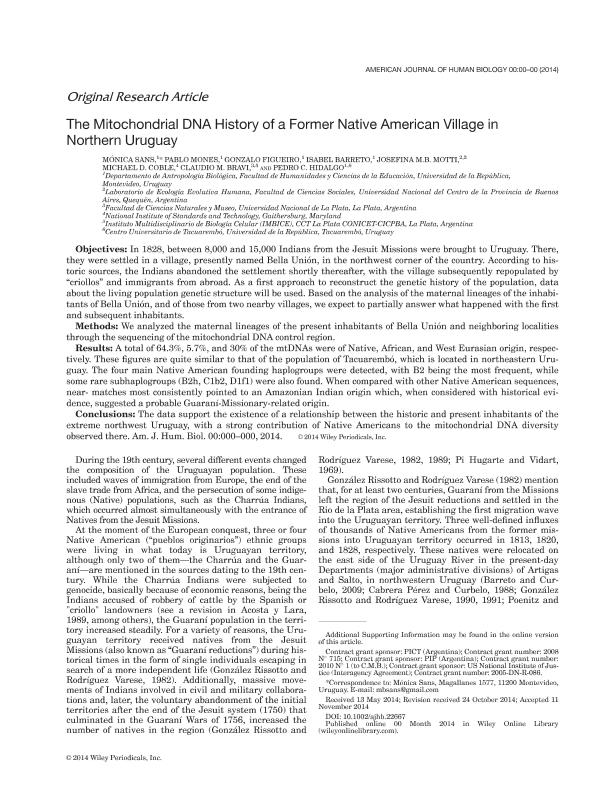Artículo
The mitochondrial DNA history of a former native American village in northern Uruguay
Sans, Mónica; Mones, Pablo; Figueiro, Gonzalo; Barreto, Isabel; Motti, Josefina María Brenda ; Coble, Michael D.; Bravi, Claudio Marcelo
; Coble, Michael D.; Bravi, Claudio Marcelo ; Hidalgo, Pedro C.
; Hidalgo, Pedro C.
 ; Coble, Michael D.; Bravi, Claudio Marcelo
; Coble, Michael D.; Bravi, Claudio Marcelo ; Hidalgo, Pedro C.
; Hidalgo, Pedro C.
Fecha de publicación:
05/2015
Editorial:
Wiley-liss, Div John Wiley & Sons Inc
Revista:
American Journal of Human Biology
ISSN:
1042-0533
Idioma:
Inglés
Tipo de recurso:
Artículo publicado
Clasificación temática:
Resumen
Objectives: In 1828, between 8,000 and 15,000 Indians from the Jesuit Missions were brought to Uruguay. There, they were settled in a village, presently named Bella Unión, in the northwest corner of the country. According to historic sources, the Indians abandoned the settlement shortly thereafter, with the village subsequently repopulated by "criollos" and immigrants from abroad. As a first approach to reconstruct the genetic history of the population, data about the living population genetic structure will be used. Based on the analysis of the maternal lineages of the inhabitants of Bella Unión, and of those from two nearby villages, we expect to partially answer what happened with the first and subsequent inhabitants. Methods: We analyzed the maternal lineages of the present inhabitants of Bella Unión and neighboring localities through the sequencing of the mitochondrial DNA control region. Results: A total of 64.3%, 5.7%, and 30% of the mtDNAs were of Native, African, and West Eurasian origin, respectively. These figures are quite similar to that of the population of Tacuarembó, which is located in northeastern Uruguay. The four main Native American founding haplogroups were detected, with B2 being the most frequent, while some rare subhaplogroups (B2h, C1b2, D1f1) were also found. When compared with other Native American sequences, near- matches most consistently pointed to an Amazonian Indian origin which, when considered with historical evidence, suggested a probable Guaraní-Missionary-related origin. Conclusions: The data support the existence of a relationship between the historic and present inhabitants of the extreme northwest Uruguay, with a strong contribution of Native Americans to the mitochondrial DNA diversity observed there. Am. J. Hum. Biol. 27:407-416, 2015.
Palabras clave:
Mitochondrial Dna
,
Haplotypes
,
Haplogroups
,
Native American
,
Admixture
,
Uruguay
Archivos asociados
Licencia
Identificadores
Colecciones
Articulos(CCT - TANDIL)
Articulos de CTRO CIENTIFICO TECNOLOGICO CONICET - TANDIL
Articulos de CTRO CIENTIFICO TECNOLOGICO CONICET - TANDIL
Articulos(IMBICE)
Articulos de INST.MULTIDISCIPL.DE BIOLOGIA CELULAR (I)
Articulos de INST.MULTIDISCIPL.DE BIOLOGIA CELULAR (I)
Citación
Sans, Mónica; Mones, Pablo; Figueiro, Gonzalo; Barreto, Isabel; Motti, Josefina María Brenda; et al.; The mitochondrial DNA history of a former native American village in northern Uruguay; Wiley-liss, Div John Wiley & Sons Inc; American Journal of Human Biology; 27; 3; 5-2015; 407-416
Compartir
Altmétricas



